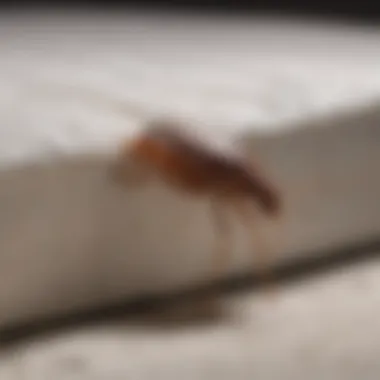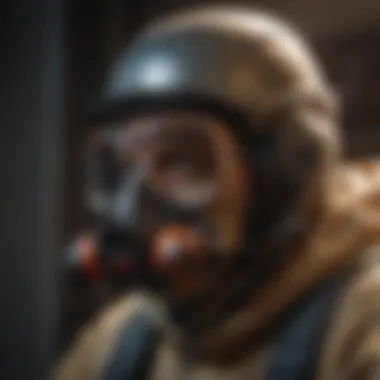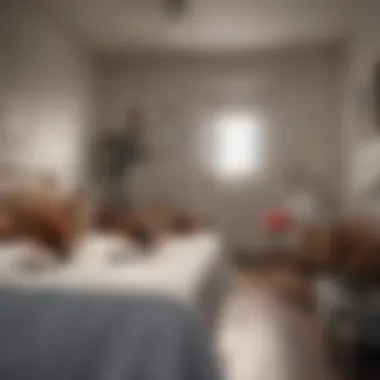Understanding Bed Bug Bombing: Techniques and Precautions


Intro
Bed bugs, small parasitic insects, are known for their ability to cause significant distress among homeowners. Understanding how to effectively manage these pests is vital for both comfort and health. This article will explore various aspects of bed bug bombing, including effective techniques, essential precautions, and the overall methodology involved.
Through an analysis of the bed bug life cycle and identification strategies, readers will gain insights into how to prevent these pests from entering homes. By employing a mix of chemical and biological control methods, it is possible to maintain a bed bug-free environment. In doing so, both homeowners and professionals can benefit from practical advice tailored to ensure successful pest management.
Understanding the Pest
Identification
Bed bugs are small, flat, and brownish insects. Adult bed bugs measure about 4 to 5 mm in length, resembling an apple seed. The first step in effective pest management is accurate identification. Their bites often leave red, itchy welts on the skin, commonly clustered in lines or groups.
Bed bugs tend to hide in cracks and crevices around the home, particularly in mattresses, bed frames, and furniture. Look for dark spots on bedding, which are typically bed bug excrement. Also, check for shed skins, as they grow through multiple stages before reaching maturity.
Life Cycle
Understanding the life cycle of bed bugs is crucial for effective treatment plans. They undergo five nymph stages before reaching adulthood. Each nymph stage requires a blood meal to molt into the next stage. Here’s a brief overview of the life cycle:
- Eggs: Females typically lay 1-5 eggs per day, with a total of 200-500 eggs in their lifetime. The eggs hatch in about 6 to 10 days.
- Nymphs: Newly hatched nymphs are transparent and become visible after feeding. They require a meal to grow and molt.
- Adults: Bed bugs reach maturity in about 4-5 weeks, depending on temperature and host availability.
This picture of their life cycle aids in comprehension of their rapid proliferation and emphasizes the need for immediate action should an infestation occur.
Pest Prevention Strategies
Environment Modification
To prevent bed bug infestations, it’s crucial to modify the environment. This includes decluttering living spaces and inspecting second-hand furniture, which may harbor these pests.
Additionally, ensuring that bedding and clothing are washed regularly at high temperatures can eliminate potential hiding spots. Also, sealing cracks and crevices in walls and furniture can reduce access points for these pests.
Physical Barriers
Physical barriers can also serve as effective prevention measures. Encase mattresses and box springs in bed bug-proof covers, which have tightly woven fabric to prevent bed bugs from entering or escaping.
Implementing bed legs with bed bug interceptors can also help to monitor and catch any bed bugs trying to climb onto the bed.
Control Methods
Chemical Control
Chemical control is often a primary approach to eliminate bed bug infestations. Various insecticides are available specifically designed for bed bugs. Treatment involves focusing on areas where bed bugs are most likely to hide.
When using these products, it’s vital to follow the instructions provided, ensuring the safety of all inhabitants. Consumers should consider products that contain pyrethroids or neonicotinoids, as they have shown efficacy against these pests.
Biological Control
Biological control methods offer alternative options for managing bed bug populations. For instance, the introduction of natural predators, such as certain types of parasitic wasps, can help control bed bug numbers without chemicals.
While less common, biological methods may provide safer options for households concerned about chemical exposure. Researching and understanding these types of controls can expand the options for bed bug management.
This article aims to provide a well-rounded understanding of bed bug control, incorporating both preventive measures and treatment options to ensure effective pest management.
Preamble to Bed Bug Infestations
Understanding bed bug infestations is crucial for effective pest management. These pests can severely disrupt home life and cause distress. Knowing their characteristics and behaviors provides a foundation for appropriate responses when encountering an infestation. This section unfolds the complexity of bed bugs, illuminating their nature and how to detect their presence. This knowledge is essential for homeowners and pest control professionals alike, as it informs decision-making regarding treatment strategies.
Defining Bed Bugs
Bed bugs, scientifically known as Cimex lectularius, are small, parasitic insects that feed on the blood of humans and animals. They are typically reddish-brown and about the size of an apple seed. Their oval shape and flattened bodies allow them to hide in various areas around homes, like cracks, crevices, and bedding. Unlike some pests, bed bugs are not known for spreading diseases. However, their bites can cause itching and discomfort, while the mere presence of these insects can lead to anxiety and sleep disturbances.


Signs of a Bed Bug Infestation
Spotting a bed bug infestation early is key for effective management. Common signs include:
- Bites on Skin: Often appearing in straight lines or clusters; they can be itchy and inflamed.
- Blood Stains: Small reddish spots on bedding or cushions from crushed bugs.
- Dark Spots: These are fecal matter left behind by bed bugs, usually found near their hiding spots.
- Shed Skin: As they grow, bed bugs molt, leaving behind exoskeletons.
- Musty Odor: A distinctive smell can sometimes indicate a significant infestation.
Early recognition of these signs can facilitate quicker and more effective treatment, thus mitigating the overall impact of these pests.
The Biology and Behavior of Bed Bugs
Understanding the biology and behavior of bed bugs helps in not just identifying them but also predicting their movements and activity patterns. Female bed bugs can lay hundreds of eggs in a lifetime, making quick population growth possible. They thrive in warm environments and usually come out at night, feeding when their hosts are asleep.
They can survive for months without feeding, making their eradication challenging. Bed bugs also exhibit a strong resistance to many common insecticides, necessitating more diligent and comprehensive extermination methods. Recognizing such biological traits is imperative for homeowners when considering various pest control approaches.
Understanding bed bugs is the first step in eradicating them. Knowledge leads to effective management.
Foreword to Bed Bug Bombing
The extermination of bed bugs can be complex and challenging. Bombing is one of the techniques often employed to manage these infestations effectively. This section aims to shed light on the significance of understanding bombig techniques. Knowledge about bombing is essential for homeowners wanting to tackle infestations or seek professional help. Knowing when and how to bomb can lead to better outcomes. This also makes it easier for pest control professionals to apply their methods efficiently.
What is Bombing?
Bombing, often referred to as fogging, involves dispersing a pesticide in aerosol form to treat an entire room quickly. The process comprises using a canister or fogger that releases insecticides designed to kill bed bugs upon contact. Bombing is advantageous because it covers a large area, ensuring fewer spots are missed during treatment. However, it requires careful execution and adherence to safety protocols.
During the bombing, the space is typically sealed to prevent the escape of the gaseous insecticides. This helps the fumigants to saturate the area, reaching all corners where bed bugs may be hiding. It's crucial to follow the instructions provided by the product manufacturer closely, as incorrect application can diminish effectiveness.
Types of Products Used for Bombing
Various products are available for bombing purposes. Choosing the right one can significantly enhance the chances of success. Generally, these products contain chemical insecticides formulated to eliminate insects effectively. Common types include pyrethroids and other synthetic chemicals. These substances are designed to provide a quick knockdown and prolonged residual effect on bed bugs.
Common categories of products include:
- Total Release Foggers: These release a significant amount of insecticide into the air, producing a fog that fills the space.
- Aerosol Sprays: These are used for spot treatments and localized applications.
- Insect Growth Regulators (IGRs): These help in disrupting the life cycle of bed bugs.
Each type has its own benefits and limitations. Users need to consider factors such as the level of infestation and area size when selecting a product. Always check product labels to ensure it is suitable for indoor use and specifically targets bed bugs.
In summary, understanding bombing techniques and the available products is crucial in managing bed bug infestations. By leveraging the right methods and applying them safely, individuals can protect their homes from the destructive presence of these pests.
Preparing for Bombing
Preparing for the bombing process is a critical phase in combating bed bug infestations. This step ensures maximum effectiveness of the treatment. Proper preparations contribute to minimizing risks, enhancing safety, and optimizing results. By taking these precautions, homeowners can significantly improve their chances of eradicating the unwanted pests effectively.
Decluttering and Cleaning the Area
Decluttering is essential for successful bed bug bombing. The presence of clutter provides hiding spots for bed bugs. This can hinder the effectiveness of the treatment. Begin by removing unnecessary items from the affected room. Focus on reducing the number of objects on surfaces and floors. This makes it easier for the fumigant to circulate throughout the space.
Once you have decluttered, proceed with a thorough cleaning. Vacuum the carpets, furniture, and corners where bed bugs might hide. Discard vacuum cleaner bags immediately after the process to avoid the possibility of escape. Cleaning does not only help remove debris but also prepares the affected area for treatment.
Identifying Affected Areas
Identifying the areas most affected by bed bugs is crucial. This step allows for targeted treatments. Start by examining common areas like beds, nightstands, and sofas. Look for signs of bed bug activity such as dark spots or shed skins. Consider using a flashlight for better visibility.
Create a map of the affected areas to keep track of where you see signs of infestation. This will help in ensuring all areas get attention during the bombing treatment. If you notice a particularly intense infestation in one spot, note it. Targeting these zones may require additional focus during the application of the bomb.
Safety Precautions to Take Before Bombing
Safety is paramount during the bombing process. Fumigants can be hazardous to health if not used correctly. Begin by reading the labels and instructions on the product you plan to use. Ensure you comply with all manufacturer recommendations. This includes guidance on personal protective equipment.
Here are some key precautions to consider:


- Remove all people and pets from the area: This is a fundamental safety procedure. Ensure no individual or animal is present during the bombing.
- Cover or remove food and utensils: Protect food items and anything you might use for cooking or eating from contamination.
- Seal off non-affected rooms: Close doors and use towels to seal gaps to prevent fumigants from spreading.
- Wait for the recommended duration: After treatment, it is important to remember the recommended waiting time before re-entering.
Taking these precautions can greatly reduce health risks during the treatment process.
Following these steps will effectively set the foundation for successful bed bug bombing. Homeowners must be patient and thorough in their preparations. The effort invested in these early stages is essential for a pest-free environment.
Executing the Bombing Process
Executing the bombing process is crucial in effectively eradicating bed bugs from an infested area. This method involves the careful application of combustion-free insecticide foggers or fumigants designed to penetrate deep into furniture, carpets, and other hiding spots where bed bugs reside. Proper execution can lead to a higher intital kill rate and contributes to long-term eradication. Understanding this process means recognizing its various components, including preparation, application techniques, and necessary post-treatment measures.
Step-by-Step Guide to Bombing a Room
A systematic approach is essential when bombing a room. Each step plays a role in ensuring precision and safety throughout the process. Here’s a step-by-step guide:
- Gather Necessary Materials: Collect all essential items, including insecticide foggers like Hot Shot Bed Bug and Flea Killer, safety gear such as masks and gloves, and cleaning supplies.
- Clear the Area: Remove all items from the area to be treated. This includes furniture, clothing, and any other belongings. Ensure that important documents or items are stored safely.
- Prepare the Fogger: Follow the manufacturer's instructions for setting up the fogger. Shake the canister well and ensure there are no leaks.
- Activate the Fogger: Place the fogger in the center of the room and activate it. Ensure windows are closed and no ventilation is present while the product is dispersing.
- Evacuate the Premises: Leave the treated area immediately. This prevents inhalation of fumes and ensures safety.
- Allow Sufficient Time: Most products indicate a minimum time for the area to be sealed and treated effectively, typically ranging from two to four hours.
- Ventilate After Treatment: After the recommended time has passed, return to the area and ventilate by opening windows and doors for at least 30 minutes.
This step-by-step guide ensures the bombing process is thorough and effective in combating bed bugs.
Duration of Bombing Treatment
The duration of the bombing treatment varies based on the product used and the severity of the infestation. Typically, the time ranges from two to six hours for the room to be sealed with the fogger activated. Some products may require longer exposure; hence, always adhere to the manufacturer’s instructions. After the application, it is important to allow the treated space to ventilate for a minimum of 30 minutes before re-entering. Longer durations can enhance effectiveness but always be cautious to avoid overexposure to chemicals.
Assessing the Room’s Ventilation
Ventilation prior, during, and after bombing is crucial. Adequate airflow can help disperse harmful chemicals and reduce residues. Prior to fogging, ensure windows are closed to retain the fog within the room. After treatment is complete, the room must be ventilated thoroughly to minimize inhalation risks.
Proper assessment of the room's ventilation ensures both effective treatment of bed bugs and safety for inhabitants. Regular checks and careful planning keep the environment conducive for both pest control and human health.
Post-Bombing Considerations
After the bombing process, several factors warrant attention. This phase ensures that the efforts made during fumigation are effective and the living environment remains safe. Understanding what to do post-bombing is crucial for optimal results. It can help households avoid potential health risks and ensure a bed-bug-free living space.
Evaluating Effectiveness
Evaluating effectiveness is vital. Once the bombing treatment is completed, assessing its success determines if further action is necessary. Homeowners should check for signs of bed bug presence in the affected area. Look for physical evidence such as:
- Live bugs
- Shed skins
- Fecal spots
If any of these are observed, it may suggest that the treatment did not fully eradicate the infestation. In such cases, a follow-up treatment may be required. Consulting with pest control professionals often brings clarity on the next steps. They can recommend additional products or alternative methods for complete eradication.
Cleaning and Sanitizing After Treatment
Once the assessment is done, cleaning the area is the next step. Cleaning and sanitizing after treatment have several benefits:
- Removes Residues: It is crucial to eliminate any remaining chemical residues from the bombing. This is not just for aesthetics; it is essential for safety.
- Prevents Reinfestation: Thorough cleaning can help eliminate any bed bugs that survived the initial treatment or those that may have been hidden.
- Improves Air Quality: Airing out the space and ventilating it can remove any lingering chemicals and odors.
To clean effectively:
- Vacuum carpets and upholstery.
- Wash beddings and any affected clothing in hot water.
- Wipe down surfaces using a mild disinfectant.
It is best to wait at least 24 hours before beginning cleaning. This allows the fumigants time to settle.
Monitoring for Reinfestation
Continual monitoring is vital in a post-bombing strategy. Bed bug reinfestation can happen, and vigilance is necessary. Homeowners should establish a routine check for any signs of bed bugs in the weeks that follow the bombing.
Consider these monitoring strategies:
- Regular Inspections: Check bedding and cracks in the furniture regularly.
- Use Bed Bug Monitors: Install monitoring traps around beds. These devices capture any bed bugs attempting to return, indicating a problem early.
- Maintain Cleanliness: Keep areas clutter-free to minimize hiding spots for bed bugs.
If signs of reinfestation are noticed, it's important to act swiftly. Contact a pest control professional for further assistance. They can offer tailored strategies based on the extent of the problem.
In summary, the post-bombing phase is an integral part of ensuring that a bed bug infestation is effectively managed. Understanding how to evaluate effectiveness, clean responsibly, and monitor for any signs of return helps in keeping the home safe and comfortable.


Safety and Health Risks Associated with Bombing
Understanding the safety and health risks associated with bombing is crucial for anyone considering this pest control method. While bed bug bombing can effectively eliminate these pests, it does come with certain hazards. The main concern is often the toxicity of the fumigants used in the process. These chemicals can pose health risks not only to the individuals applying them but also to anyone who may occupy the space afterward. Therefore, it is important to take these risks seriously and implement proper safety measures.
Potential Hazards of Fumigants
Fumigants are designed to penetrate spaces and kill insects effectively. However, they can also be harmful to humans and pets. Here are some potential hazards to consider:
- Respiratory issues: Fumigants can irritate lungs and airways. Those with asthma or other chronic respiratory conditions may experience exacerbated symptoms.
- Dermal exposure: Skin contact with these chemicals can lead to rashes, burns, or other irritations.
- Chemical sensitivity: Some individuals may have heightened sensitivity to chemicals, leading to more severe reactions.
- Environmental concerns: Chemical residues left behind can potentially affect indoor air quality and harm the surrounding environment.
It's vital to read all safety labels and guidance provided by manufacturers before using any fumigant. If you have any doubts, consulting with a professional pest control service is advisable.
Health Precautions for Vulnerable Populations
Certain populations might be more susceptible to the health risks posed by bombing. These include children, pregnant individuals, elderly people, and those with pre-existing health conditions. Here are some essential precautions:
- Evacuation: It is crucial to have all individuals and pets vacate the premises during the bombing process. This helps to prevent exposure to harmful chemicals.
- Timing: Plan bombings for times when vulnerable individuals are least likely to be present, such as during school hours or when they are away from home.
- Communication: Ensure that everyone involved is informed about the process, including post-bombing re-entry times.
- Post-treatment evaluation: After bombing, wait for the recommended duration before re-entering the space. This allows chemicals to dissipate and reduces potential health risks.
"Effective pest control must prioritize the health and safety of its users first and foremost."
By being aware of these risks and taking necessary precautions, homeowners can effectively mitigate health dangers while dealing with bed bug infestations.
Alternatives to Bombing
Considering the prevalence of bed bugs, many individuals seek effective methods to eradicate these pests. While bombing is a common approach, it's essential to assess alternatives. This section explores various techniques and solutions that can complement or serve as substitutes.
Other Pest Control Techniques
Several pest control strategies exist. Each comes with its own benefits and drawbacks. Some of the more significant options include:
- Heat Treatment: This technique involves raising the temperature of infested areas to levels lethal for bed bugs. Typically, temperatures above 120°F (49°C) are effective. It often requires specialized equipment but can provide permanent results after one application.
- Chemical Insecticides: Many over-the-counter options are available. These insecticides can be sprays, powders, or aerosols. They should be used with caution due to potential health risks. Always follow the manufacturer's instructions for safety.
- Diatomaceous Earth: This is a natural powder derived from fossilized algae. It deters pests by damaging their exoskeletons upon contact. While it is not an instant solution, it can help monitor and control bed bug populations over time.
- Vacuuming: Regular vacuuming can physically remove bed bugs and their eggs. Pay close attention to seams of mattresses, carpets, and cracks in furniture. After vacuuming, make sure to dispose of the vacuum bag securely.
Using a combination of these methods often yields the best results. Each method has unique pros and cons involving cost, effectiveness, and effort invested.
Integrating Eco-Friendly Solutions
In an age focused on sustainability, eco-friendly pest control methods attract increasing attention. Choosing these methods not only benefits your household but also the environment.
- Essential Oils: Certain oils, such as lavender and tea tree oil, can repel bed bugs. They serve as a less toxic alternative for those cautious about chemicals. Diluted essential oils can also be used to create a home spray.
- Freezing: Exposing infested items to extreme cold can eradicate pests. Bagging items and placing them in a freezer at 0°F (-18°C) for at least four days is recommended. This approach is ideal for clothing and small items.
- Natural Predators: Some beneficial insects, such as ladybugs and lacewings, will prey on bed bugs. While not practical for large infestations, they can help in controlling smaller populations.
- Encasements: Protective covers for mattresses and pillows can trap bugs and prevent new infestations. Look for high-quality products designed specifically for this purpose.
Using eco-friendly methods often requires more patience. However, they promote a safer living environment and contribute to a sustainable future.
Integrating various strategies typically leads to more robust pest management.
Combining thorough cleaning with eco-friendly solutions and traditional insecticides can lead to effective outcomes without the need for bombing. Always consider the specific circumstances of the infestation before deciding on the method to employ.
The End
In summarizing the significance of bed bug bombing, this article highlights key elements involved in effective pest management. The process of bombing an infested area can yield substantial benefits when executed correctly. Proper techniques, such as choosing the right products and adhering to safety precautions, are crucial. These elements not only ensure the effective elimination of bed bugs but also minimize risks to inhabitants and pets.
By understanding the mechanics of bed bug bombing, readers can enhance their preparedness. This critical knowledge empowers homeowners to make informed decisions, thereby improving their living conditions. Failure to follow guidelines can lead to ineffective treatments or even worse, harm to health.
"Comprehensive understanding leads to effective solutions in pest control."
Summarizing Key Points
- Definition of Bombing: Bombing is a method of fumigation used to combat bed bug infestations. It involves applying aerosol insecticides in a specific area.
- Preparation: Preparation for bombing includes decluttering the space and ensuring proper ventilation. Safety precautions must be observed to avoid adverse health effects.
- Execution and Monitoring: Following a systematic approach during the bombing process is essential for efficacy. Monitoring the treated area post-bombing is key to assess success.
- Potential Risks: Awareness about potential hazards related to chemical substances used is important for the safety of vulnerable groups.
- Alternatives and Eco-Friendly Solutions: Considering alternatives or integrating eco-friendly strategies can be beneficial for long-term pest control.
Future Implications for Pest Management
Looking ahead, the understanding of bed bug bombing methods will continue to evolve. As new technologies and products become available, pest management practices will likely adapt. Environmental considerations are gaining importance, leading to innovations in less harmful treatments.
The role of education in pest control remains crucial. Homeowners and pest professionals alike must stay informed about the latest findings. Increased awareness will facilitate more responsible and safer methods of dealing with bed bug infestations.
Thus, determined efforts are necessary to shape a future where pest control is not only effective but also safe for everyone.







